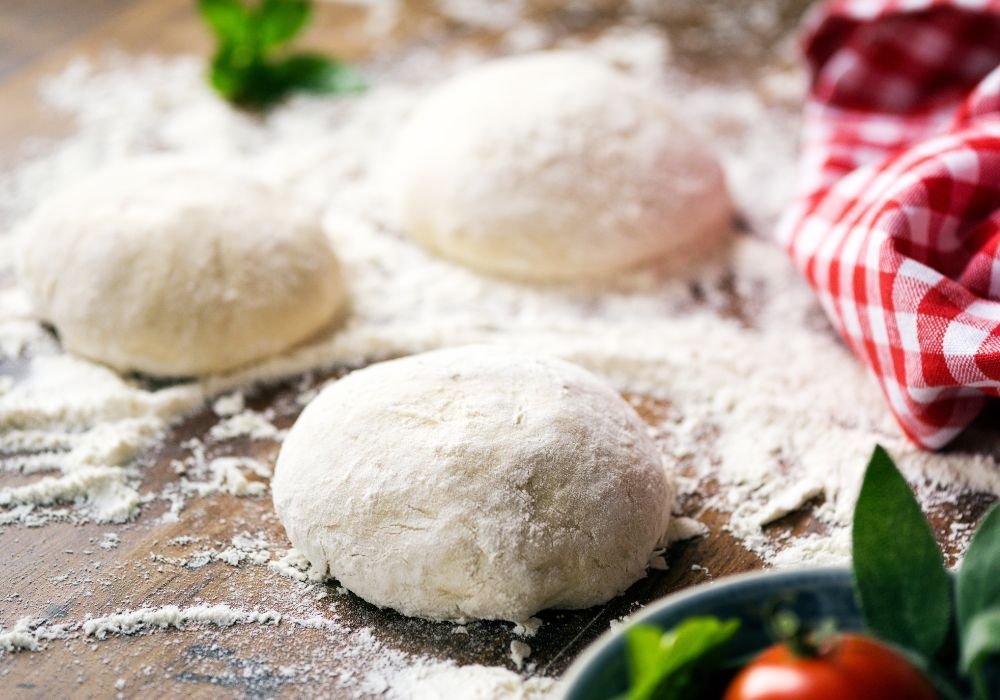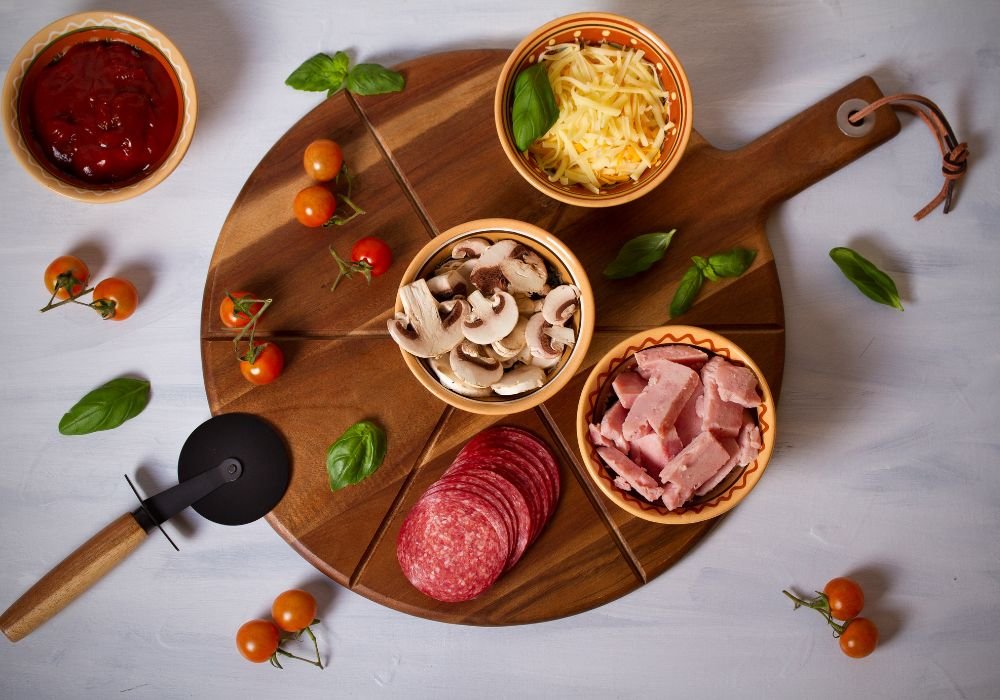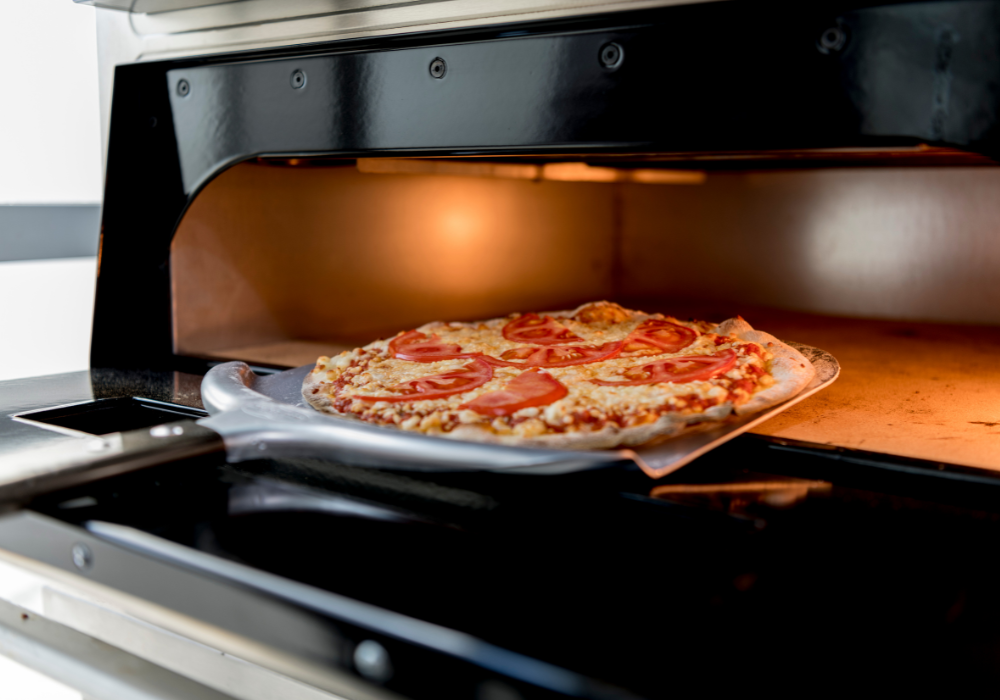Pizza is more than just a dish; it’s a universally loved comfort food that brings people together. Originating from Italy, this iconic food has evolved into countless varieties, from thin-crust Neapolitan to thick, cheesy deep-dish. The secret to a perfect pizza lies in balancing a crisp, airy crust with rich, flavorful toppings, and creamy melted cheese. While restaurants use specialized equipment to achieve the ideal bake, it’s entirely possible to recreate this experience at home with the right ingredients, techniques, and a bit of practice. Ready to master the art of homemade, restaurant-quality pizza? Let’s get started!
Choosing the Right Ingredients for Restaurant-Quality Pizza
Here’s a detailed guide with ingredient quantities for making a standard 12-inch pizza, which yields a crust of about 1/8 to 1/4-inch thickness, perfect for one to two people.
1. Flour
- Quantity: 2 ½ cups (300 grams) of ‘00’ flour or bread flour.
- Yield: This amount produces a dough that, when stretched, forms a 12-inch pizza crust with a soft and chewy texture.
2. Yeast
- Quantity: 1 teaspoon (3 grams) of instant yeast.
- Yield: Allows the dough to rise adequately, creating a light, airy crust.
3. Water
- Quantity: ¾ cup (180 ml) of lukewarm water.
- Yield: Helps achieve the perfect dough consistency, forming a 12-inch pizza base.
4. Salt
- Quantity: 1 teaspoon (5 grams) of fine sea salt.
- Yield: Balances flavors in the 12-inch pizza, enhancing the overall taste.
5. Olive Oil
- Quantity: 1 tablespoon (15 ml) of extra virgin olive oil.
- Yield: Adds richness and helps in creating a crispy outer crust for the 12-inch pizza.
6. Cheese
- Quantity:
- 1 cup (100-150 grams) of shredded mozzarella.
- Optional: ¼ cup (25 grams) of grated Parmesan or Pecorino.
- Yield: Covers a 12-inch pizza with a balanced layer of creamy, melty cheese.
7. Tomatoes
- Quantity: 1 cup (240 ml) of canned San Marzano tomatoes, crushed.
- Yield: Provides enough sauce for a 12-inch pizza with the right balance of flavor and moisture.
8. Herbs and Spices
- Quantity:
- 1 teaspoon of dried oregano.
- 4-5 fresh basil leaves (added after baking).
- Optional: 1 clove of garlic, minced.
- Yield: Seasoning that compliments the ingredients on a 12-inch pizza.
9. Toppings
- Quantity: Use a handful of each topping, like ½ cup of thinly sliced pepperoni or ¼ cup of sautéed mushrooms.
- Yield: Covers the 12-inch pizza without making it too heavy or soggy.
With these ingredients and quantities, you’ll create a perfectly balanced, restaurant-quality 12-inch pizza that looks, smells, and tastes like it’s fresh out of a wood-fired oven.
Perfecting the Dough

Creating a restaurant-quality pizza at home starts with perfecting the dough. The process involves several key steps to achieve the ideal texture and flavor.
1. Mixing the Dough
- Combine Ingredients: Mix 2 ½ cups (300 grams) of flour, 1 teaspoon (3 grams) of yeast, and 1 teaspoon (5 grams) of salt in a large bowl.
- Add Water: Gradually add ¾ cup (180 ml) of lukewarm water while mixing.
- Olive Oil: Add 1 tablespoon (15 ml) of extra virgin olive oil to hydrate the dough and enhance flavor.
2. Kneading the Dough
- Manual Kneading: Knead the dough on a floured surface for 8-10 minutes until it’s smooth and elastic.
- Stand Mixer: Alternatively, use a stand mixer with a dough hook for 6-8 minutes.
- Windowpane Test: Check the dough’s readiness by stretching a small piece to see if light passes through without tearing.
3. First Rise (Bulk Fermentation)
- Shaping: Form the dough into a ball and place it in an oiled bowl.
- Cover and Rest: Let the dough rise at room temperature for 1-2 hours until it doubles in size.
- Slow Fermentation Option: For better flavor, refrigerate the dough for 24-72 hours, allowing yeast to develop complex flavors.
4. Shaping the Dough
- Divide and Shape: After rising, punch down the dough, then divide if making multiple pizzas.
- Forming the Crust: Shape the dough into a disc using fingertips, then stretch and rotate with knuckles.
- Edge Formation: Leave a thicker border around the edge to create a puffy crust.
5. Second Rise (Proofing)
- Rest Again: Let the shaped dough rest for 20-30 minutes on parchment paper or a floured peel, covered loosely.
- Final Shaping: Stretch the dough if needed before adding toppings to maintain shape and size.
6. Tips for Perfect Dough
- Hydration Levels: Adjust water based on flour type and climate.
- Handling Dough: Use minimal flour to avoid drying or toughening the dough.
- Practice: Experiment with different flours, hydration, and fermentation times to perfect your technique.
By mastering these steps, you can create a perfect pizza dough with a crispy, chewy texture, ideal for your favorite toppings.”
Crafting the Sauce
A balanced sauce is crucial for a great pizza, enhancing the crust and toppings without overpowering them.
1. Choosing the Right Tomatoes
- San Marzano Tomatoes: Best for pizza sauce due to their sweetness and low acidity. Look for DOP-certified canned versions.
- Alternative Options: Use quality canned whole plum tomatoes if San Marzano is unavailable. Avoid pre-made sauces with additives and excess sugar.
2. Preparing the Sauce
- Crushing Tomatoes: Hand-crush for a rustic texture or blend lightly for a smoother consistency. Avoid over-pureeing.
- Removing Excess Liquid: Strain watery tomatoes to achieve a thicker sauce, preventing soggy pizza.
3. Adding Flavor
- Salt: Start with ½ teaspoon and adjust to enhance the natural sweetness.
- Olive Oil: Add 1-2 tablespoons for richness and a silky texture.
- Garlic: Sauté minced garlic for a robust flavor.
- Herbs: Add dried oregano or fresh basil for classic taste.
4. Optional Additions
- Sugar: Balance acidity with a pinch of sugar, if needed.
- Crushed Red Pepper Flakes: Add for heat.
- Balsamic Vinegar: A tiny splash for depth and subtle sweetness.
5. Cooking the Sauce
- Raw Sauce: Use uncooked for a bright, tangy flavor.
- Simmering: Cook for 15-20 minutes for a richer taste.
6. Final Touches
- Consistency Check: Thick but spreadable. Adjust seasoning to taste.
7. Storing and Using
- Storage: Keep in the fridge for up to 5 days or freeze in portions.
- Application: Use 2-3 tablespoons for a 12-inch pizza to avoid sogginess.
By following these steps, you’ll create a vibrant, balanced pizza sauce. For more detailed instructions, check out this comprehensive pizza sauce preparation guide.
Choosing the Best Toppings for Your Pizza

Selecting the right toppings is key to creating a balanced, delicious pizza that enhances the crust and sauce without overwhelming them. Here’s how to pick and prepare the best toppings for a restaurant-quality pizza at home.
1. Cheese
- Mozzarella: A classic choice for its melting qualities. Use fresh mozzarella for a creamy texture or low-moisture mozzarella for less wateriness.
- Blends: Mix mozzarella with provolone, fontina, or cheddar for complexity. Add Parmesan or Pecorino Romano for a salty finish.
- Blue Cheese: Crumble on top after baking for an adventurous flavor.
2. Meats
- Pepperoni: Thin slices offer a spicy kick and crisp texture. Place under cheese to prevent burning.
- Sausage: Use cooked Italian sausage, mild or spicy, for a savory topping.
- Prosciutto: Add post-baking for a delicate, salty flavor.
- Chicken: Pre-cooked, shredded chicken pairs well with barbecue or white sauces.
3. Vegetables
- Bell Peppers: Add sweetness and crunch; choose red, yellow, or orange for color.
- Mushrooms: Sauté to remove moisture and intensify flavor.
- Onions: Thinly slice or caramelize for sweetness and depth.
- Spinach: Place under cheese to avoid drying. Pairs well with white sauces.
- Olives: Add sparingly for a salty touch.
4. Gourmet Toppings
- Arugula: Add post-baking for a peppery bite.
- Goat Cheese: Crumble for tanginess; pairs well with figs or honey.
- Truffle Oil: Drizzle after baking for an earthy aroma.
- Figs and Prosciutto: Combine for a sweet-and-salty flavor; add balsamic glaze for extra depth.
5. Balancing Toppings
- Less is More: Avoid overloading to prevent sogginess.
- Flavor Pairings: Complement flavors like salty and sweet or spicy and creamy.
- Texture: Balance crunchy with creamy or chewy elements.
6. Prepping Toppings
- Pre-Cooking: Cook raw meats and dense vegetables beforehand.
- Moisture Control: Remove excess moisture to prevent sogginess.
- Thin Slicing: Ensure even cooking and distribution.
7. Specialty Pizzas
- Margherita: Keep it simple with fresh mozzarella, tomato sauce, and basil.
- Meat Lovers: Combine various meats with extra cheese.
- Vegetarian: Use a variety of vegetables with feta or goat cheese.
8. Timing of Adding Toppings
- Before Baking: For most toppings to meld flavors.
- After Baking: For delicate items like herbs and arugula.
Choosing and balancing toppings thoughtfully creates a delicious, visually appealing pizza that perfectly complements the crust and sauce.
The Secret to the Perfect Crust
The crust is the foundation of any great pizza, and achieving the ideal balance of crispiness, chewiness, and flavor requires specific ingredients, techniques, and tools.
1. Choosing the Right Flour
- ‘00’ Flour: Best for a soft, chewy crust with a delicate texture, suitable for high-temperature baking.
- Bread Flour: A good alternative with a higher protein content for a chewy crust.
- Hydration Level: Aim for 65-70% hydration for a lighter, airier crust.
2. Proper Dough Fermentation
- Room Temperature Fermentation: Let the dough rise for 1-2 hours to develop gluten structure.
- Cold Fermentation: Refrigerate for 24-72 hours for better flavor and texture.
- Resting Time: Bring the dough to room temperature before shaping for easier handling.
3. Shaping the Dough
- Gentle Handling: Press and shape the dough with your fingertips, avoiding a rolling pin to maintain airiness.
- Stretching: Use knuckles to stretch the dough, preserving air bubbles.
- Forming the Edge: Leave a thicker border, or “cornicione,” for a puffy crust.
4. Baking Surface and Temperature
- Pizza Stone: Preheat at 500°F (260°C) for at least 30 minutes for a crisp bottom.
- Baking Steel: Retains heat effectively for an even crisper crust.
- Direct Oven Floor: Start on the oven floor for an intense bake, then finish on stone or steel.
5. Baking Temperature and Time
- High Heat: Bake at 500-550°F (260-290°C) for a quick cook, achieving a crispy exterior and soft interior.
- Preheating: Preheat oven and baking surface for 30 minutes.
- Baking Time: 8-12 minutes for thin crust; 4-6 minutes for Neapolitan-style.
6. Managing Moisture and Crispiness
- Flour or Cornmeal: Use on the peel to prevent sticking and add crispiness.
- Steam: Use steam for a crisp crust. For more insights on how steam can enhance your cooking, check out the guide on steam ovens for cooking.
- Avoid Overloading: Use minimal sauce and toppings to prevent sogginess.
7. Finishing the Crust
- Olive Oil Brush: For flavor and sheen.
- Garlic Butter: Brush for richness and flavor.
- Herbs and Cheese: Sprinkle Parmesan or oregano for extra flavor.
These techniques will help you achieve a restaurant-quality crust that’s crispy, chewy, and full of flavor.
Achieving the Restaurant-Style Bake

Baking a perfect pizza at home requires understanding different oven types and their capabilities to replicate the high heat and quick cooking times of a restaurant-quality pizza.
1. Conventional Ovens
- Features: Standard home ovens with top and bottom heating, no airflow.
- Temperature Setting: Preheat to the highest setting, around 500-550°F (260-290°C).
- Tips:
- Use a pizza stone or steel, preheated for 30 minutes, to mimic a brick oven.
- Place pizza close to the bottom for a crispier crust.
- Use the broiler for 1-2 minutes at the end to achieve a bubbly top.
2. Convection Ovens
- Features: Use a fan to circulate hot air for even cooking and browning.
- Temperature Setting: Reduce by 25°F (15°C) from conventional settings, around 475-500°F (245-260°C).
- Tips:
- Monitor closely as toppings may cook faster.
- Rotate the pizza halfway for even browning.
For more on the benefits of convection ovens and how they enhance the baking process, check out our detailed article.
3. Pizza Ovens
- Features: Reach high temperatures of 700-900°F (370-480°C) for quick baking.
- Temperature Setting: Ideal for Neapolitan-style pizzas, baking in 60-90 seconds.
- Tips:
- Use higher hydration dough and minimal toppings to avoid burning.
4. Outdoor Pizza Ovens (Wood-fired or Gas)
- Features: Achieve 800-900°F (425-480°C) for authentic pizza with wood-smoke flavor.
- Temperature Setting: Maintain consistent high heat.
- Tips:
- Use well-seasoned hardwoods or quality gas burners.
- Turn the pizza every 20-30 seconds for even cooking.
5. Electric Pizza Makers
- Features: Compact appliances with top and bottom heating elements.
- Temperature Setting: Max out at 650°F (343°C).
- Tips:
- Preheat thoroughly and monitor closely. Best for small pizzas.
6. Baking Tools for Better Results
- Pizza Stone: Absorbs and retains heat, simulating traditional ovens.
- Baking Steel: Provides even heat distribution for a crisp crust.
- Pizza Peel: Facilitates easy transfer to and from the oven.
7. Baking Techniques
- Positioning: Bake on the middle or lower rack. Use the top briefly for charring.
- Steam for Crust: Add a dish with water for steam to create a crispy crust.
- Timing: Thin-crust pizzas bake in 6-10 minutes; thicker crusts take 12-15 minutes.
By optimizing oven settings and using the right tools, you can achieve a crispy crust and beautifully melted toppings, replicating the restaurant-style pizza at home.
Tips and Tricks
Elevate your homemade pizza with these expert tips and tricks for achieving restaurant-quality results.
1. Dough Handling and Preparation
- Resting Dough: Let the dough rest for 30 minutes before shaping to relax gluten and ease stretching.
- Double Fermentation: Ferment at room temperature, then refrigerate for 24-72 hours for enhanced flavor and texture.
2. Stretching the Dough
- Avoid the Rolling Pin: Stretch dough by hand to preserve air bubbles for a light crust.
- Knuckle Stretching: Use knuckles to gently stretch the dough, letting gravity maintain uniform thickness.
3. Managing Moisture and Soggy Crusts
- Less is More: Use a light layer of sauce and moderate toppings to prevent sogginess.
- Pre-Cook Vegetables: Sauté watery vegetables like mushrooms and bell peppers to reduce moisture and concentrate flavors.
4. Optimizing Oven Performance
- Preheat Thoroughly: Preheat oven, pizza stone, or steel for at least 30 minutes for even cooking.
- Rotate the Pizza: Rotate halfway through baking to ensure uniform cooking and browning.
5. Toppings and Flavor Enhancements
- Fresh Herbs: Add herbs like basil or arugula after baking to preserve their flavor.
- Finishing Oils: Drizzle olive, truffle, or chili oil after baking for a rich finish.
- Grated Cheese: Sprinkle Parmesan or Pecorino Romano post-bake for a savory boost.
6. Experimentation and Customization
- Try Different Flours: Mix flours like whole wheat or rye for unique textures.
- Infused Dough: Add herbs, garlic, or cheese to the dough for a flavored crust.
7. Baking and Serving
- Use a Pizza Peel: Dust with flour or cornmeal to transfer pizza easily.
- Let it Rest: Allow pizza to rest for a few minutes post-baking to set cheese and toppings.
These tips will improve your pizza-making process, making it more efficient and enjoyable. Practice and experimentation are key to mastering the perfect pizza. Happy baking!
Experimenting with Pizza Flavors

Pizza offers endless possibilities for creativity, whether sticking to traditional combinations or exploring new, unexpected pairings.
1. Exploring Different Sauces
- Classic Tomato Sauce: Add twists like roasted garlic or red wine for depth.
- White Sauce: Béchamel or Alfredo pairs well with spinach and mushrooms.
- Pesto: Use basil or arugula pesto for a fresh taste.
- Barbecue Sauce: Perfect for meat-centric pizzas with pulled pork or chicken.
2. Unique Cheese Combinations
- Ricotta and Mozzarella: Creamy and mild.
- Gorgonzola and Mozzarella: Sharp contrast.
- Goat Cheese: Pairs well with figs and caramelized onions.
3. Creative Topping Ideas
- Sweet and Savory: Prosciutto with figs or pears.
- Spicy: Sausage with jalapeños and hot honey.
- Seafood: Shrimp or smoked salmon with light sauces.
4. International Inspirations
- Mexican: Salsa base with ground beef and avocado.
- Mediterranean: Hummus with roasted peppers and feta.
- Asian: Hoisin with chicken and bell peppers.
5. Herb and Spice Infusions
- Infused Oils: Garlic or herb-infused oil.
- Fresh Herbs: Add basil or cilantro post-bake.
6. Playing with Crust Flavors
- Garlic-Herb Crust: Knead garlic and herbs into dough.
- Stuffed Crust: Add cheese or pesto inside.
7. Post-Bake Finishes
- Fresh Greens: Add arugula or spinach.
- Drizzles: Balsamic glaze or truffle oil.
8. Customizing for Dietary Preferences
- Vegan Options: Dairy-free cheese and plant-based toppings.
- Gluten-Free Crusts: Use almond flour or cauliflower dough.
Experiment with these flavors to transform your homemade pizza into a gourmet masterpiece!
Troubleshooting Common Issues
Making pizza at home can be challenging. Here’s how to solve common problems:
1. Soggy Crust
- Problem: Too much sauce, wet toppings, or low baking temperature.
- Solution:
- Use less sauce and moderate toppings.
- Pre-cook vegetables to reduce moisture.
- Preheat the oven and pizza stone to at least 500°F (260°C).
2. Dough Doesn’t Rise
- Problem: Inactive yeast, wrong water temperature, or short fermentation time.
- Solution:
- Check yeast by testing in warm water with sugar.
- Use lukewarm water (105-110°F or 40-43°C).
- Allow enough fermentation time, 1-2 hours at room temperature or 24-72 hours in the fridge.
3. Dough Tearing or Shrinking
- Problem: Insufficient gluten development or improper handling.
- Solution:
- Knead until smooth and elastic.
- Let the dough rest for at least 30 minutes before stretching.
4. Burned Crust or Toppings
- Problem: Oven too hot or pizza too close to the heating element.
- Solution:
- Place pizza on the middle rack.
- Monitor and rotate pizza halfway through baking.
5. Tough or Chewy Crust
- Problem: Overworked dough, too much flour, or low baking temperature.
- Solution:
- Handle dough minimally.
- Use enough flour to prevent sticking.
- Bake at high temperature, 500-550°F (260-290°C).
6. Uneven Baking
- Problem: Oven hot spots or uneven toppings.
- Solution:
- Rotate pizza halfway through baking.
- Distribute toppings evenly.
7. Crust Too Thick or Thin
- Problem: Improper stretching or overworking.
- Solution:
- Stretch gently by hand, maintaining consistent thickness.
8. Pizza Sticks to the Peel
- Problem: Sticking to the peel.
- Solution:
- Dust peel with flour or cornmeal.
- Transfer quickly, shaking peel to ensure movement.
Addressing these issues will improve your homemade pizza-making skills. Practice and patience are key!
Conclusion
Mastering restaurant-quality pizza at home is all about complete ingredients with perfect ratio, proper making process & most important: understanding of your oven. Each type of oven has unique features and temperature requirements that can significantly impact the outcome. Conventional ovens benefit from using a preheated pizza stone, while convection ovens need careful monitoring of toppings. Pizza ovens and outdoor ovens, with their high heat, are perfect for quick bakes and authentic textures. Electric pizza makers are ideal for small pizzas. No matter your setup, preheating and the right baking tools like pizza stones or steels can help achieve a crispy crust and beautifully melted toppings. Your oven is the key to replicating the restaurant experience at home!
Share this content:













2 comments